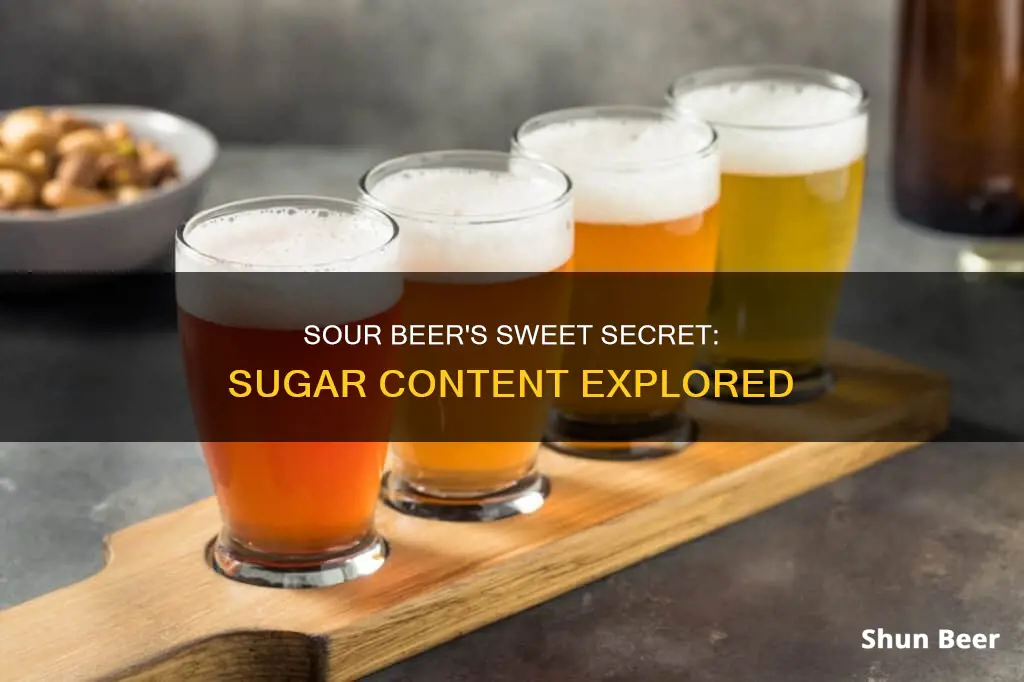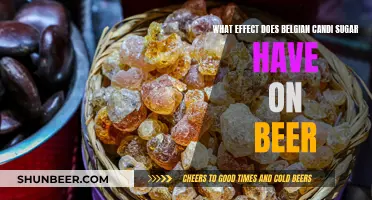
Sour beer is a unique brew that has gained popularity among seasoned beer drinkers and novices alike. With its distinctively sour taste, this style of beer is created through a specific brewing process that uses wild bacteria and yeast, setting it apart from other beers that employ controlled yeast strains. While the sugar content in sour beers may vary, it is important to understand the role of sugar in the brewing process.
Sugar plays a crucial role in the fermentation process, where yeast converts fermentable sugars into alcohol and carbon dioxide. The amount of residual sugar left behind contributes to the beer's taste and body. The type of yeast and fermentation process used in sour beers can impact the sugar content, with some yeasts being more efficient at fermenting sugar than others.
Additionally, the bacteria used in sour beers, such as lactobacillus and pediococcus, also consume sugar and produce lactic acid, further contributing to the sour flavour. The addition of fruit during the aging process can also affect the sugar levels in the final product.
While it may be challenging to determine the exact sugar content in sour beers, understanding the brewing process and the role of sugar can provide valuable insights into this unique style of beer.
What You'll Learn
- Sour beers are made with wild yeast and bacteria, like lactobacillus and pediococcus, which feed on sugar
- Sour beers are not brewed in a sterile environment and are often aged in wooden vessels
- Sour beers are not made with traditional brewer's yeasts like saccharomyces cerevisiae
- Sour beers are usually lower in alcohol content than other beers, ranging from 2-9% ABV
- Sour beers are notoriously difficult to make and require a long aging period

Sour beers are made with wild yeast and bacteria, like lactobacillus and pediococcus, which feed on sugar
Sour beers are made with wild yeast and bacteria, such as lactobacillus and pediococcus, which feed on sugar. This process gives the beer its distinctive sour taste. The bacteria lactobacillus, for example, converts sugar into lactic acid, resulting in lower pH levels and a tarter flavour. Pediococcus, on the other hand, produces unique flavours and aromas that lactobacillus might not, giving "wild" yeasts more to react with.
The sugar in sour beer comes from the grains used in the brewing process, not from direct addition. During fermentation, yeast converts these sugars into alcohol and carbon dioxide. This step is critical in determining the beer's final sugar content. While most sugars are converted, the residual sugar that remains gives the beer its body and flavour.
Sour beers are notoriously difficult to make and require a long ageing period, which can be off-putting for some brewers. The ageing process can take anywhere from 3 to 18 months, or until the desired level of sourness and lactic acid concentration is reached.
Sour beers have a long history and are considered the forefathers of many modern beers. The first sour beers were brewed in Belgium in the early 18th century, and the style remained difficult to find in America until the 1970s. Since then, sour beers have become increasingly popular among beer drinkers worldwide.
Priming Beer with Sugar: The Ultimate Guide
You may want to see also

Sour beers are not brewed in a sterile environment and are often aged in wooden vessels
Sour beers are unique in that they are not brewed in a sterile environment. Instead, they are made by intentionally allowing wild yeast strains or bacteria into the brew, usually during the cooling of the wort in a coolship open to the outside air, or through the barrels. The most common microbes used to intentionally sour beer are the bacteria Lactobacillus and Pediococcus, and the fungus Brettanomyces.
The use of wild yeast and bacteria is what gives sour beers their distinctive tart, crisp, and funky flavours. However, it also means that the brewing process is less controlled and more time-consuming. Sour beers can take months to ferment and potentially years to mature, as the yeast and bacteria work slowly to turn sugar into lactic acid.
To encourage the development of wild yeast and bacteria, sour beers are often aged in wooden vessels, usually oak barrels. The use of wooden vessels allows communities of organisms to live in the beer, enhancing its unique flavour profile.
The process of brewing sour beer is quite different from that of other beers. First, the grain is mashed and allowed to rest, then it is rinsed to extract as much sugar as possible. A small amount of aged hops is added to the boil, as too many hops could inhibit bacterial growth. The wort is then cooled and transferred to a secondary fermentation vessel, where yeast and bacteria are added.
The fermentation process can take several months or even years, depending on the desired level of sourness and lactic acid concentration. Finally, the beer is bottled and ready to be enjoyed.
Goldberg Beer: Sugar Content and Nutritional Facts
You may want to see also

Sour beers are not made with traditional brewer's yeasts like saccharomyces cerevisiae
Saccharomyces cerevisiae, on the other hand, is highly efficient at fermenting sugar and is the main yeast used in clean beers. It is also sometimes used in sour beer production, but it is not responsible for the sour taste. Instead, it acts as a base yeast, protecting the wort and setting the stage for wild fermentation.
The use of wild yeasts and bacteria in sour beer production is part of what makes these beers so unique and challenging to make. The long aging period, which can last from three to eighteen months, also discourages some brewers from attempting to make sour beers. However, the resulting beers are well worth the effort for those who do, offering a taste explosion that leaves patrons puckering up and coming back for more.
In addition to wild yeasts, sour beers often incorporate living bacteria such as lactobacillus and pediococcus, which convert sugar into lactic acid, giving the beer its signature sour, tart flavour. These bacteria can also be found in food fermentations such as kimchi and yogurt. Some brewers also add fruit during the aging process to enhance the flavour profile and spur secondary fermentation.
The use of wild yeasts and bacteria, along with the long aging process, results in a beer that is quite different from traditional beers. Sour beers typically have a lower alcohol content, ranging from 2% to 8% or 9% ABV, and their unique flavour profiles make them a favourite among seasoned beer drinkers and novices alike.
Lite Beer and Sugar: What's the Truth?
You may want to see also

Sour beers are usually lower in alcohol content than other beers, ranging from 2-9% ABV
The alcohol content of a beer can vary depending on various factors, such as the type of beer, the ingredients used, and the brewing process. Sour beers, in particular, are known for their tangy and tart flavour profile, often resulting from the presence of wild yeast and bacteria during the fermentation process. This unique flavour contributes to their popularity among craft beer enthusiasts.
While the alcohol content in sour beers may be lower than that of other beers, it's important to note that they still contain a significant amount of alcohol. As with any alcoholic beverage, it's essential to consume sour beers in moderation to avoid negative health effects. Moderation is typically defined as no more than one to two standard drinks per day for women and men, respectively.
In terms of sugar content, beer generally contains very little added sugar. The sugar present in beer comes from the processing of grains, such as barley and wheat, during the malting and mashing steps of the brewing process. This sugar is then fermented by yeast to produce alcohol. Therefore, the final sugar content of sour beers may vary depending on the initial gravity and the efficiency of the yeast in converting sugar into alcohol.
Additionally, it's worth noting that beer manufacturers sometimes add sugar-containing ingredients like honey or corn syrup to their recipes to enhance the flavour of their beer. However, the sugar content of beer is often overshadowed by its carbohydrate content, which can also impact blood sugar levels.
In summary, sour beers typically have a lower alcohol content than other beers, ranging from 2-9% ABV. While they may contain less alcohol, they still possess a significant amount, and moderation is key. The sugar content in sour beers is generally low, as most of the sugar is converted into alcohol during fermentation, but it can vary depending on the specific brewing process and ingredients used.
Caramelizing Brown Sugar for Beer: The Perfect Brew Pairing
You may want to see also

Sour beers are notoriously difficult to make and require a long aging period
It's challenging to determine the exact sugar content in a sour beer, as manufacturers are not required to report this information. However, we can make some general observations about the sugar content in beer and the specific challenges of brewing sour beers.
Beer typically contains very little sugar, although light beers like Miller Lite tend to have a slightly higher sugar content. The sugar in beer comes from the processing of grains and is then fermented by yeast to produce alcohol. This process results in a low final sugar content, especially in ales, which have a higher alcohol tolerance and thus a lower remaining sugar content.
Sour beers, in particular, are known for their long aging period and complex brewing process. They can be created in several ways, including traditional souring methods and quicker modern techniques. Traditional sour beers are often produced by transferring the beer into barrels that harbor specific cultures of desirable bacteria and yeast, such as Pediococcus and Brettanomyces. This process can take a minimum of six months to a year or longer, as these microbes work slowly to produce the desired level of sourness and complexity of flavors.
The challenge of brewing sour beers lies in the time required and the delicate balance of microorganisms needed to achieve the desired flavor profile. Brewers must carefully select and combine different strains of yeast and bacteria, monitor the fermentation process, and allow sufficient time for the slower-fermenting microbes to contribute to the beer's flavor.
In summary, while the exact sugar content in a sour beer may vary, the lengthy aging period and complex fermentation process of sour beers suggest that the final sugar content is likely to be low, as the sugar is fermented into alcohol over an extended period.
Beer vs. Whiskey: Sugar Content Face-off
You may want to see also
Frequently asked questions
The sugar content of sour beer varies depending on the specific type of beer and the ingredients used. However, beer is generally made without adding sugar to the ingredients. Instead, the sugar comes from the processing of grains and is then fermented by yeast to produce alcohol.
Sour beers are not necessarily healthier than other beers. While they may have less sugar, they still contain alcohol, which can affect your blood sugar levels and contribute to calories.
Sour beer is a variety of beer that has a distinctively sour taste due to the use of wild bacteria and yeast in the brewing process, whereas regular beers use controlled strains of yeast to produce more familiar flavours.







